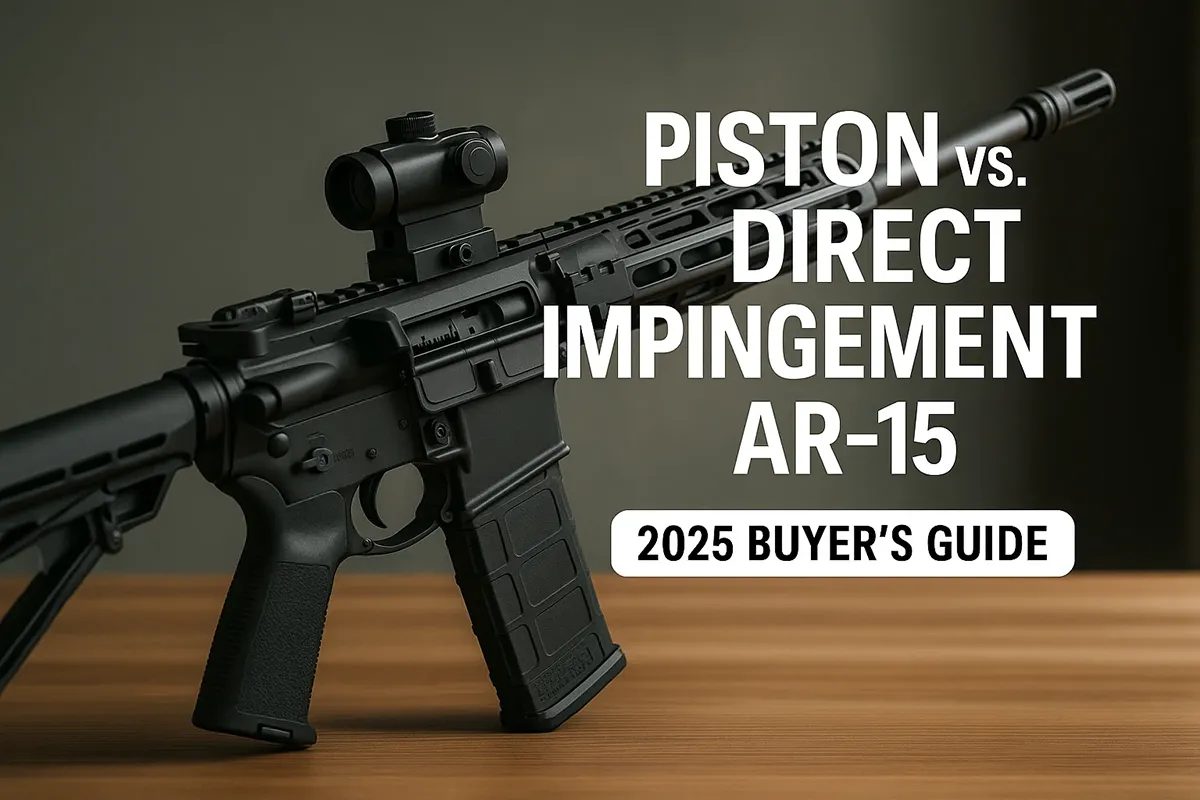Piston vs. Direct Impingement AR-15: 2025 Buyer’s Guide
November 7, 2025

If you shoot suppressed, run high round counts, or want a cleaner-running carbine, a piston AR makes sense—at a price. For lighter weight, broad parts compatibility, and easier tuning, direct impingement (DI) still rules the value/performance sweet spot. Pick based on use case, not internet arguments.
In 2025, the “piston vs. DI” debate is alive and well—and, yes, a little spicy. Here’s the level-headed breakdown: DI remains the dominant pattern thanks to its lighter front end, vast parts ecosystem, and proven reliability when properly gassed and maintained. Piston systems (short-stroke or long-stroke) shift heat and carbon forward, generally run cleaner at the bolt, and can be more forgiving with cans or adverse conditions. Below, we map the tradeoffs so you can choose the right system for your role—range, duty, hunting, or competition—without falling into the comment-section trap.
The Trend
Over the last few seasons, two shifts stand out. First, suppressor use is mainstream now, not niche, and shooters expect rifles to cycle smoothly with less gas-in-face. Second, lightweight hunting/“general purpose” builds are popular, and every ounce at the muzzle matters for balance. That drives a split: piston rifles gaining traction in suppressed/duty roles, while DI remains the go-to for weight-conscious builds and wallet-friendly upgrades.
If you’re browsing factory options, start with semi-auto rifles to compare specs across patterns, barrel lengths, and gas systems.
Spec Highlights & Standouts
- Weight & Balance: DI guns usually win here because there’s no piston/op-rod hardware hanging off the barrel. For hunters hiking miles or 3-gunners sprinting between positions, that forward ounce count matters.
- Suppressed Manners: Piston rifles often vent gas forward and can feel softer and cleaner at the bolt with a can attached. DI setups can match that behavior with the right tune (adjustable gas block, buffer system), but it takes intention.
- Heat & Carbon: Piston shifts crud toward the gas block; DI dumps heat/carbon into the carrier. Practically, piston BCGs stay cleaner longer, while DI requires more regular lube/maintenance—still simple and fast once you know your schedule.
- Parts Ecosystem & Cost: DI is the “F-150 of rifle patterns”—massive aftermarket, easier to find replacement parts, and lower cost for equivalent accuracy/triggers/barrels.
- Accuracy: With quality barrels and ammo, both systems can shoot. Free-floated barrels and consistent gas timing matter more than “DI vs. piston” by itself.
Comparisons
Below are quick contrasts among well-known makers you’ll find in the U.S. market. Use these as starting points, then dive deeper by brand:
- LWRC (piston specialist): Known for robust short-stroke piston uppers, proven in adverse conditions with good suppressed manners. Explore LWRC on GunGenius.
- Patriot Ordnance Factory (POF) (piston & DI): Offers innovative weight-saving touches and enhanced gas systems across both patterns. See Patriot Ordnance Factory.
- Daniel Defense (DI stalwart with tuned gas): Excellent barrels and reliable DI setups that run clean with proper lube and an adjustable block if you add a can. Browse Daniel Defense.
Quick reality check: “Piston = runs forever, DI = jams” is a myth. Well-built DI rifles are boringly reliable when gassed right and fed decent ammo. Conversely, poorly tuned piston guns can be over-gassed or heavy-muzzled. The devil is in the details.
What to Watch Next
- Adjustable Gas as Standard: Expect more factory rifles—both DI and piston—to ship with user-adjustable gas for suppressed vs. unsuppressed.
- Lighter Piston Front-Ends: Makers are shaving ounces with skeletonized blocks and slimmer op-rods to chase DI-like balance.
- Cartridge Flex: From 5.56 to 300 BLK, and niche favorites like 6mm ARC, we’re seeing gas packages optimized per caliber instead of “one-size-fits-all.”
- Hunting-Ready Builds: Think 16–18″ barrels with good muzzle threads/brakes, sensible handguard lengths, and optics-ready rails—whether DI or piston, the hunting crowd wants turn-key utility.
Use-Case Cheat Sheet
- Home Defense / Patrol: If you run a suppressor or must deal with variable ammo, a piston upper/rifle can reduce gas blowback and ease post-shift cleanup. If you’re unsuppressed and budget-minded, a DI carbine with a properly sized gas port and good buffer system is superb.
- Hunting / Field Carry: Ounces make pounds. DI generally balances lighter out front—nice for offhand shots or long hikes. Piston can still work great; just pay attention to barrel profile and overall weight.
- Competition: Most shooters favor DI for weight and recoil feel. That said, you’ll see piston rigs in “tough-mudder” style matches where dust, mud, and rain are part of the program.
- Training / High Round Count: Piston can stretch cleaning intervals at the bolt; DI stays cost-efficient for barrels/bolts you’ll eventually shoot out anyway.
Tuning Tips (Pattern-Agnostic)
- Gas First: Whether DI or piston, adjustable gas blocks (or selectable piston settings) are worth it, especially if you add a can later.
- Buffer & Spring: A matched buffer/spring combo tames cyclic rate and smooths recoil.
- Muzzle Device: Brakes reduce muzzle rise but add blast; compensators split the difference; flash hiders are friendlier indoors.
- Keep Notes: Document settings, ammo, and ambient conditions. Future-you will thank present-you.
Example Builds (Conceptual)
- Lightweight GP DI: 16″ mid-length DI, pencil or “government” profile barrel, adjustable gas block, A5-length buffer system, 12.5–13.5″ free-float rail, 1-6x LPVO—great for training, matches, and deer in brushy ranges with proper loads.
- Suppressed-First Piston: 14.5–16″ short-stroke piston upper with selectable gas (N/ S/ O), 13.5″ rail for can-inset mounting, robust BCG, and a red-dot + magnifier—optimized for clean, smooth cycling.
Where to Browse
- Compare current options across semi-auto rifles and filter by brand/gas system as you plan your build or purchase.
- Brand hubs to start your short list:
- LWRC (piston)
- Daniel Defense (DI)
- Patriot Ordnance Factory (hybrid lineup)
(One light quip, as promised): Choose wisely and your range buddy’s “actually…” speech will be blissfully short.
Browse related models on Semi-Auto Rifles.